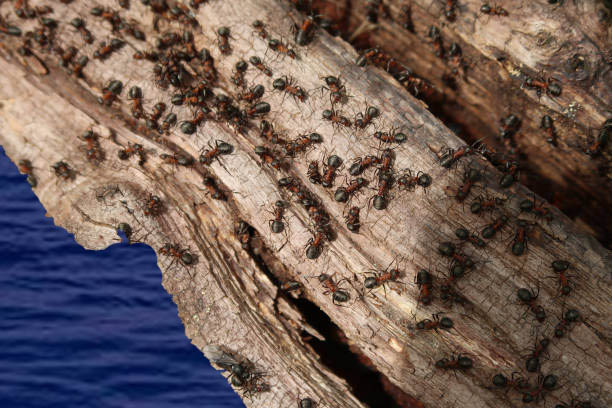
SUNDAY, 9/17/2023: NOTE TO FILE

Pathway to Modernity
We are ants on a log
Eric Lee, A-SOCIATED PRESS
Abstract: Insights from the past are to pass on, e.g. the "ants on a log" metaphor can reframe our belief in political solutions and our illusion that we (at least we who vote) are running the show. Jack Alpert is the source of my learning about this story:
“Ants on a log, floating down the river (to the waterfall), and each ant thinking he was steering” is an old political metaphor. The following was printed in The Daily Gazette (Lawrence, KS) on May 3, 1906:"These delegates remind me of a story an old logging friend of mine used to tell," he remarked, and everybody stopped to listen as they always do when Vandegrif begins a story. "He said that every spring when his logs came down the river, every log was covered with ants, and every ant thought he was steering the log."
This faction won the right (power) to pretend they are steering the Log of Progress (to unforeseen waterfall).
COOS BAY (A-P) — As long as we collectively believe in political solutions, we are ants on a log, cluelessly unaware of our condition, unable to change our trajectory (e.g. get off the log that ants did not evolve to live on, have no viable future on long term).
What if we are all a bunch of ants on 195 sovereign logs (some big, some small) in a rushing river bumping up against each other, and we think that if we put the right ants in power that they will steer our log the way we want it to go (via “change we can believe in” that will “make our log great again” on a rushing river whose flow is at least sustainable, unlike the fossil fueled matter-energy flows that support modern techno-industrial life as we expansionist humans know it)?
What if those who claim they are steering our log (who may actually believe they are) are not? What if almost everything we think we know is error floating on a river of ignorance in a thick fog of illusion — a social construct of consensus storytelling (i.e. of belief-based assertion)? What if “things are in the saddle and ride mankind?” What if there is a waterfall ahead?
Some scientists note that while the decibel level of background roar is increasing (e.g. species extinction, climate change), the outcome is not absolutely known and that those who attribute the sound to a hypothetical “waterfall” ahead are known doomers.
Maybe 95% of scientists can’t imagine any other reason for the increasing background roar other than a large waterfall ahead, but Elon Musk, humanists, transhumanists, longtermists and ethical altruists (and their scientists) are deeply concerned that a failure to progress towards our singularity (e.g. failure caused by contraction of the economy or population degrowth) could threaten the trillions of people yet to be born and shorten the Anthropocene, so the path forward is to keep on keeping on as usual. The prospect of running aground, of hitting the shore, of slowing down GDP growth…, is terrifying.
Our global civilization’s unfolding injury-trajectory results from the collected behaviors of 8 billion ants that believe they (or their leaders) control the “flows” of mass and energy about them. These belief-based behaviors create momentum that locks in a trajectory that creates injury (going over the falls) that for most is beyond their capacity to think (until they are going over and in free fall see the Rocks of Dissipation getting rapidly closer).
We know bumping the shore can happen (e.g. the Great Depression), but no one has ever told stories of going over a putative “waterfall” because there probably are not any apart from the ones doomers believe in (some claim the people living in the Indus Valley Civilization went over a “waterfall,” but why all of them chose to leave the Indus Valley to live elsewhere, and stop reading and writing Harappan, is unknown).
[Per Wikipedia: 'Around 1900 BCE signs of a gradual decline began to emerge, and by around 1700 BCE most of the cities had been abandoned. Recent examination of human skeletons from the site of Harappa has demonstrated that the end of the Indus civilisation saw an increase in interpersonal violence and in infectious diseases.... According to historian Upinder Singh, "the general picture presented by the late Harappan phase is one of a breakdown of urban networks and an expansion of rural ones."... there was a general decrease in long-distance trade.... Stone sculptures were deliberately vandalised, valuables were sometimes concealed in hoards, suggesting unrest, and the corpses of animals and even humans were left unburied in the streets and in abandoned buildings. During the later half of the 2nd millennium BCE (1500–1300 BCE), most of the post-urban Late Harappan settlements were abandoned altogether. Subsequent material culture was typically characterised by temporary occupation, "the campsites of a population which was nomadic and mainly pastoralist" and which used "crude handmade pottery."' Note: Downslope = 600 years and no literate Harappan survived, likely beyond the first 100 years on the downslope.]
The human predicament is that each of the 8+ billion individuals on 195 logs, living by the current form of civilization’s rules of the game, are not using a matter-energy systems’ view that would select for a new social contract (new rules of the game), ones that explicitly sought to minimize injury potentials (e.g. of dying a Malthusian death).
------------------------------------------------------------------
Dr. Tom Murphy, of Do the Math fame, has a map of a pathway to modernity. And a couple of days ago Medium writer Indi.ca offered his comments on Murphy's pathway: The Long Road To Ruin How civilization took a wrong turn thousands of years ago [member-only, Medium paywalled].
Tom's Pathway to Modernity:
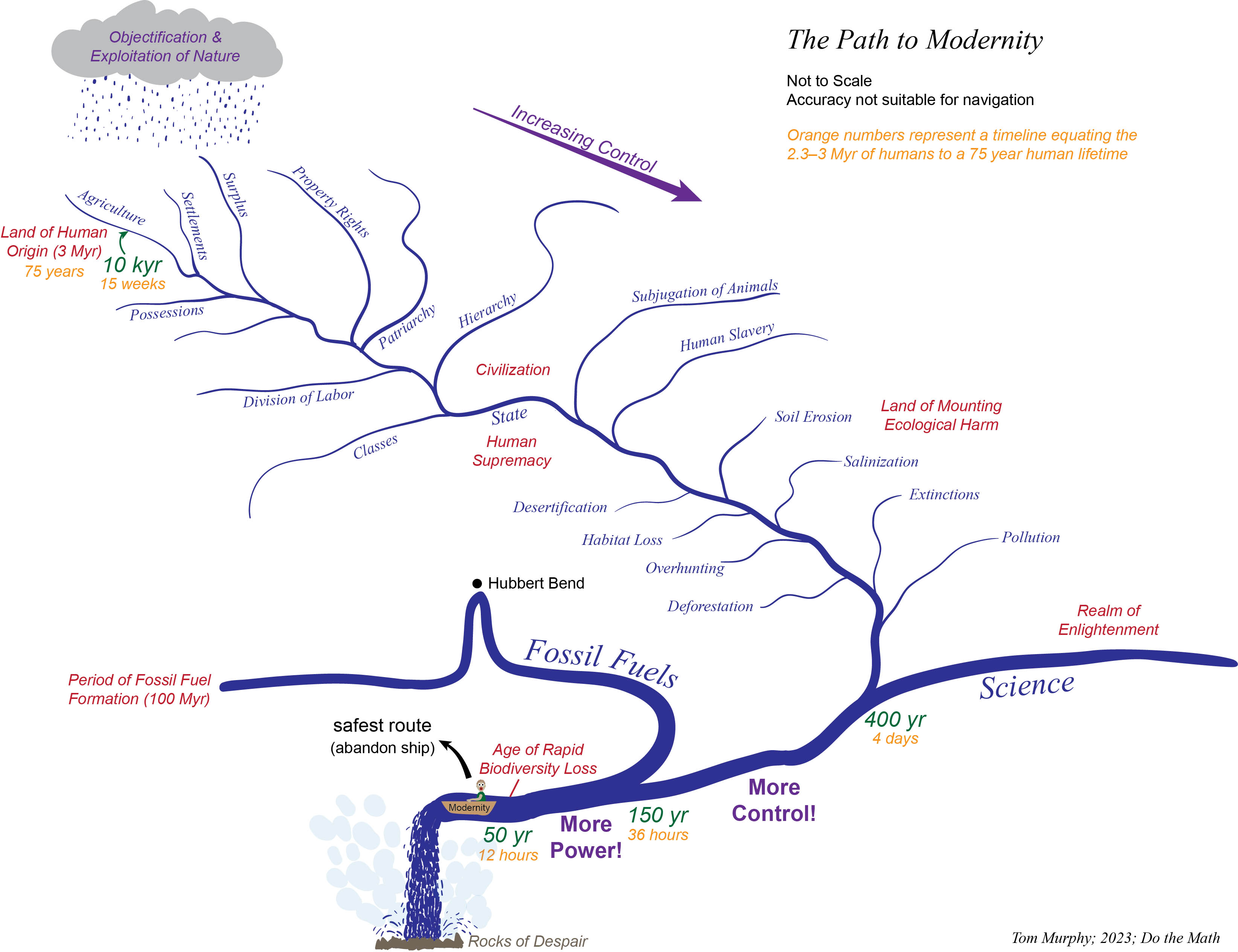
The Carboniferous Period was about 300 million years ago.
The increasing control was over the consensus narrative as shared illusion until the conceptual house of mirrors collapses.
Those few who walk away from Omelas choicelessly do what they must and take no known or knowable safe route to anywhere.
Eric's Pathway to Modernity:
Rather than comment on Murphy’s view, I decided to, as usual, steal his idea and rework it to resemble my idiosyncratic view of the human past, present, near future, life, the universe and everything (i.e. worldview).
The following summarizes a story of the predicament of techno-modernized humans who will assess it to be outside of any consensus narrative they can approve of. Therefore it is wrong (doesn't come from the Blah Blah Blah Cloud of Verities). Eight billion dysfunctional ants can't be wrong. Believe it or not.
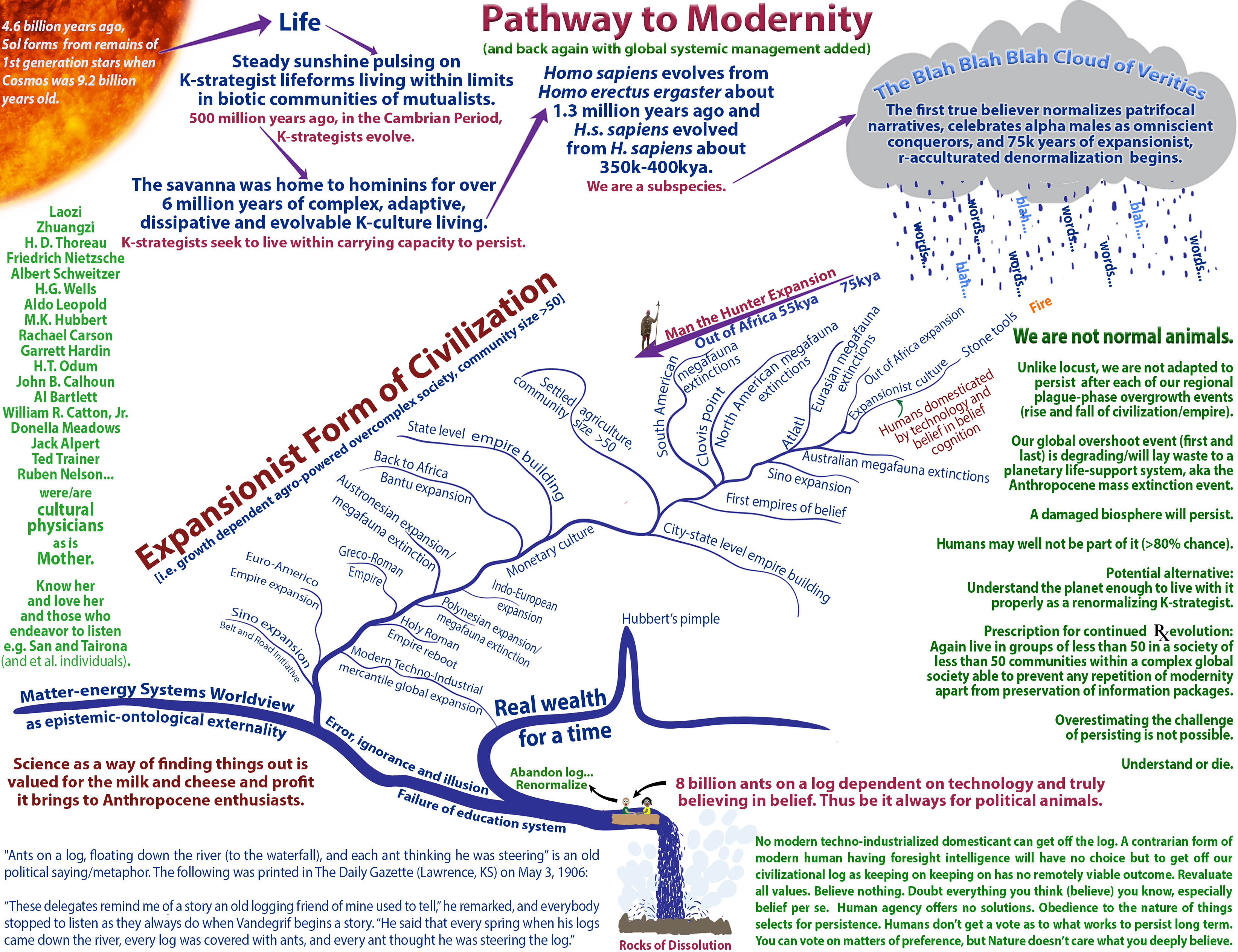
The Man the Hunter expansionism transitioned to the expansion of complex societies in the form of Empires of Belief
prior to the coming of Empires of Conquest dependent on and served by True Believers providing social control.
That humans (not dogs) were the first domestic animal (bottle gourds were the first domesticated plant) is as noted by John Livingston in detail in his book Rogue Primate (the dog form of domesticant serves humans, human domesticants serve technology and the Blah Blah Blah Cloud of Verities, aka ideology, the dynamics of complex belief-based concept-mongering prattle).
If “the most you can hope from [life] is some knowledge of yourself — that comes too late” [J. Conrad], then a “know then thyself” story is to endeavor to tell (as a likely story) of human origins and our recent (last 50k years) trajectory to the fall.
That we moderns, the Lord Man expansionistic form of human, one that eliminated (typically by killing the adult males and breeding the females) all other humans (exceptions being some San, Hadza, Sandawe and Pygmy) and hominins (along with many other forms of megafauna), is not a story our bones and artifacts tell clearly enough for us moderns to see what is in front of our pug-nosed primate faces (apart from the faces of some archaeogeneticists starting 2009 who told the story of our “Great Expansion” by 2012 which none of us rationalizing animals Liked and Shared for some reason (or lack thereof).
Could ten thousand dysfunctional ants get off the 195 logs (i.e. 8 billion don’t, sorry about that), auto-organize to renormalize enough within perhaps an eight to twenty generation period (while also preserving information packages) to then iterate towards a viable K-culture form of civilization able to prevent future r-culture denormalization? Such paradigm shifting change may seem challenging, but how could we know the half of it? We are not yet even playing the high-stakes endgame having our extinction or worse (repetition of pattern by remnant populations) as outcome.
Unless some humans (or all 8 billion) can come to understand the planet and learn to live with it properly (if 8 billion, then initially by rapid degrowth), then perhaps when the exobiologist from Omicron passes by in a few million years, there will be a human on the planet who can explain the ruins and how the layer of microplastics and radionuclides formed. Or the ruins and stratigraphic layers will tell the story. Nature doesn’t care. Have a nice Ant-thropocene.
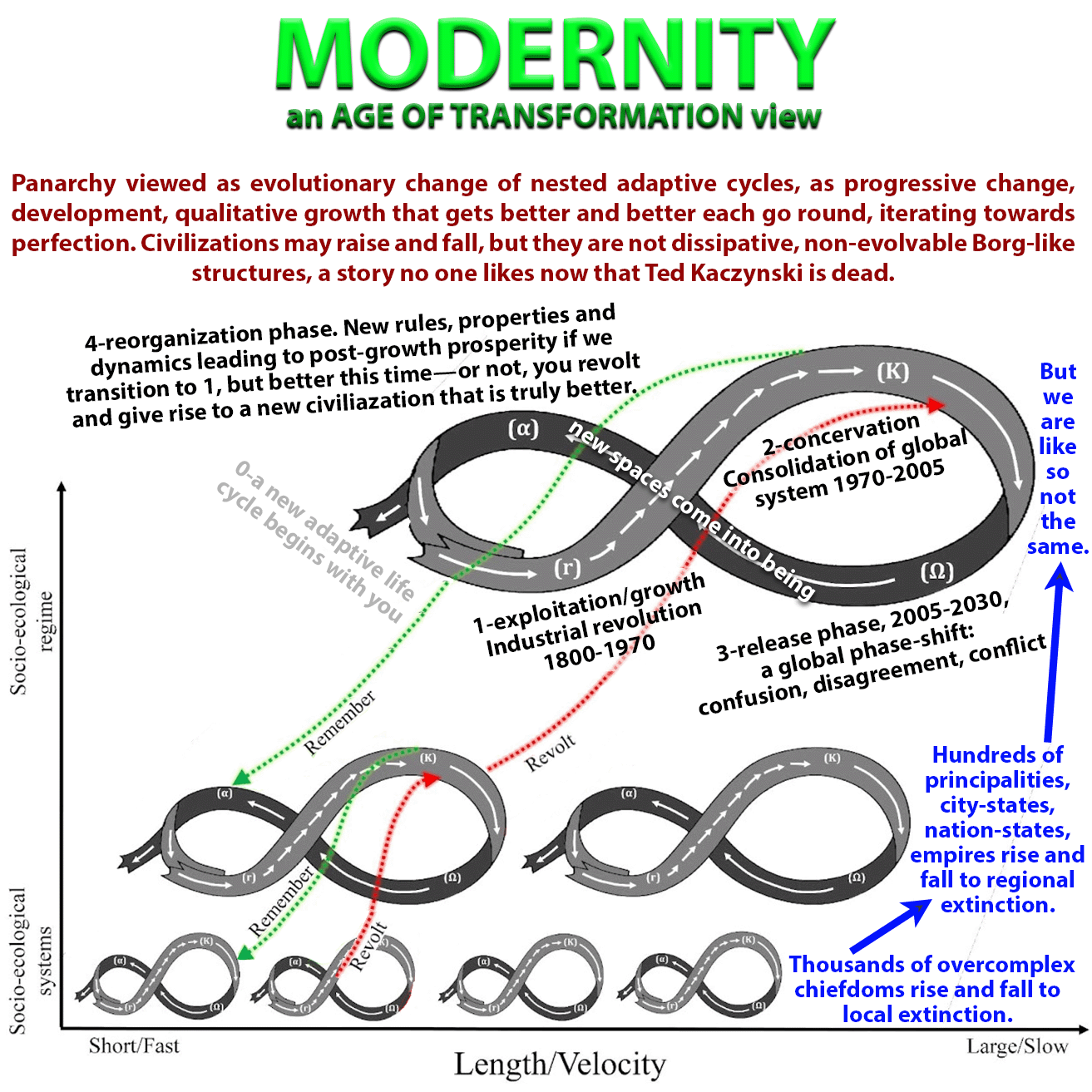
The above is from Is the Collapse of Civilization an Unprecedented Opportunity? Collapse is not the end — it’s the beginning, in the view of Nafeez Ahmed. The exit from the cycle indicated at the left of the figures suggests, in a stylized way, the stage where the potential can leak away and where a flip into a less productive and organized system is most likely [Holling 2002]. So some of the good old bits might leak away and the next cycle might not be better, but this possibility is hardly worth mentioning, and so in most graphics of the adaptive cycle it is omitted.
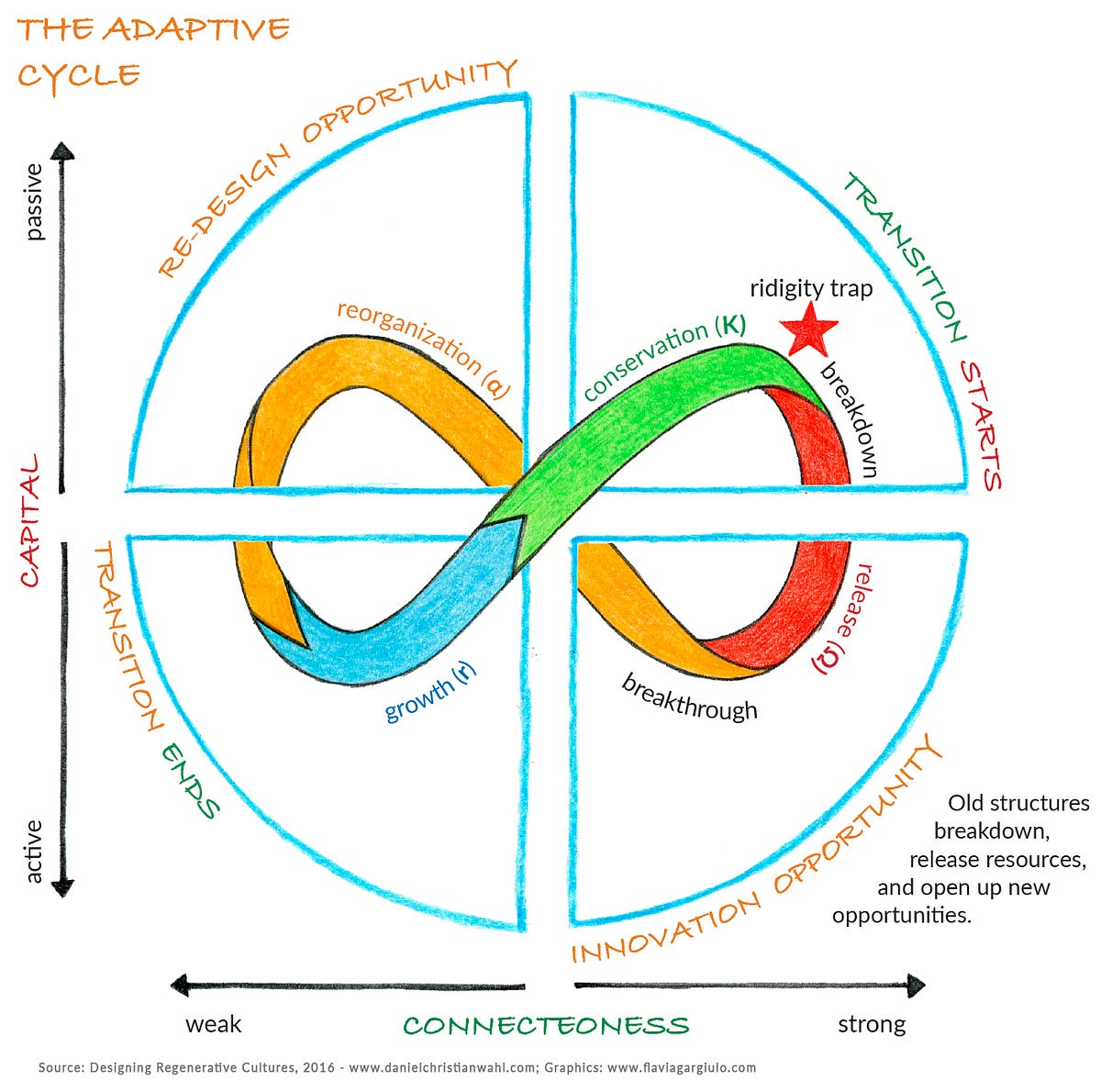
Each go-round just gets better and better, e.g. we are the most highly developed, advanced civilization ever.
Oh, but what if each time you play the adaptive cycle game you lose 4 out of 5 times? Not so adaptive. Actually, misadaptation cycles would be the correct name. Did I add “Failure of education system” to my graphic? I should have. Earlier this year I took a short 8-week course in ecological design from Gaia Education, an example of pretend education.
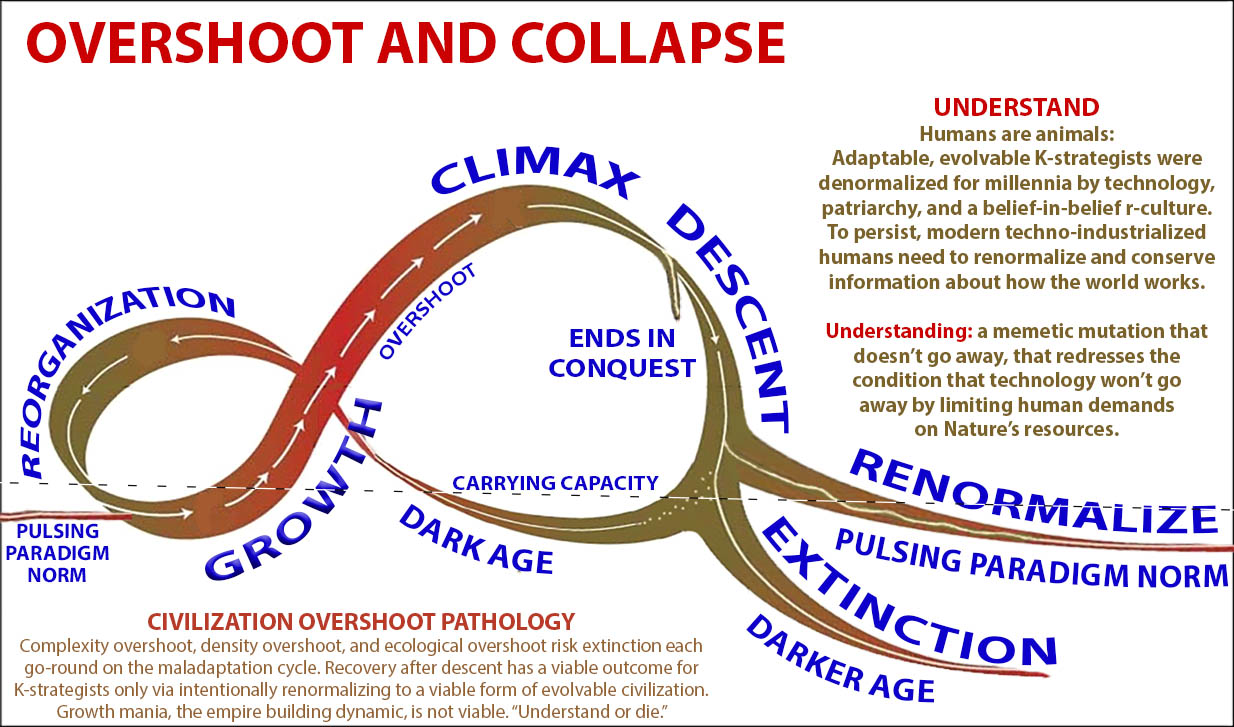
The panarchy story of a hierarchy of adaptive cycles evolving towards perfection is Pollyannaish. Long term, playing the overshoot and collapse game has no viable outcome, which is why K-strategists, for over 500 million years, have evolved to not play it (doing so tends to destroy/degrade the system the species is a dependent subsystem of). We expansionistic, obligate invasive species form of human have an expansionist r-culture that views living within limits as profoundly abnormal, a violation of natural law (MPP, the 4th law). Overexploiting an area and then moving on to a new one just over the horizon has worked for us for 50+k years, a SHORT TERM payoff.
We are nearing the climax of a fossil fueled one-off, global plague-phase overshoot event to which, unlike locust, we are not adapted to doing over and over. Playing the maladaptation cycle game is like playing Russian roulette with a five-chamber revolver with four bullets in it. To win, don’t play the game. If you “win” you just get to build another empire and play again. Get off the log. Walk away from Omelas, the whole form of modern techno-industrial civilization we are captured by and serve.
And the short of it? An inability to consider the possibility that we 8 billion ants are not normal, that we could be wrong, will be the dissolution of us.
The ‘ants on a log’ part of the meme is central. The ‘heading towards a waterfall’ is an embellishment. If no waterfall (chaotic collapse), then the log ends up in the ocean, drifts into the surf’s tormented roar, and same outcome. Anchoring the log so it doesn't go over the waterfall or out to sea can't work as ants can't live/reproduce/evolve on a log. The condition of ants on a log is ant-ecology non-viable and focusing on a near future endgame (collapse, even if likely) is a distraction. Our expansionist form of human is non-viable whether we go splat on the wall of biophysical limits or fade away over multiple generations.
Humans take note — attention, Red Alert: Anagenesis occurs when a species evolves within a single lineage. Modern humans (Homo sapiens insapiens) began with the Great Expansion within and out of Africa 50k to 60k years ago, as an anagenetic/memetic change of form from a K-strategist/K-culture species to an r-culture imposed upon a biological K-strategist that has resulted in continued r-culture selection and change in gene frequencies among 99.9999% of humans (exceptions, San and Hadza) today (i.e. some genetic change, but vast cultural change in worldview and mindset). Our expansion/growth-mania culture strongly selects for individual fitness (e.g. economic, political, religious) in a way that is lethal for the human population long term. Individual understanding of this dynamic is the only deliverance possible from it if such individuals can auto-organize into a renormalized form of human able to persist through the coming bottleneck/dissolution of modern techno-industrialized humans.
“What has survival value for the individual may be lethal for the population …” — Gregory Bateson
To recognize that the unfortunate child kept in perpetual filth, darkness, and misery to enable Omelas to prosper is a metaphor for prosperity, is an insight fatal to one’s Anthropocene enthusiasm. Our consumer life of evermore, our dependency on technology/ideology selects for a non-viable outcome.
Our way of life is an overshoot debt that posterity, your children, all younger than you (and maybe you, but that’s another distraction) will pay. Don’t believe anything. Seek to understand the dynamics of the world system, which involves being nature centric. To understand is the walking away. Believing you should walk away (or celebrate your prosperity) is antithetical to understanding anything.
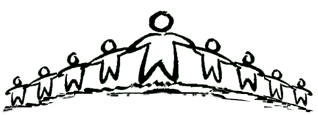
A human centric worldview.
The mind clings to its image of the world, to its narratives of it.
We call it real only because of our ignorance.
Do not seek after the truth, merely cease to cherish your opinions.
— Seng-Ts’an, 6th century CE
Listening to Nature, who has all the answers, is alternative to seeking and finding what we desire/cherish.
"As is your sort of mind, So is your sort of search—you’ll find What you desire." ― Robert Browning
Self-organizing, nonlinear feedback systems are inherently unpredictable. They are not controllable. They are understandable only in the most general way. The goal of foreseeing the future exactly and preparing for it perfectly is unrealizable. The idea of making a complex system do just what you want it to do can be achieved only temporarily, at best. We can never fully understand our world, not in the way our reductionistic science has led us to expect. Our science itself, from quantum theory to the mathematics of chaos, leads us into irreducible uncertainty. For any objective other than the most trivial, we can’t optimize; we don’t even know what to optimize. We can’t keep track of everything. We can’t find a proper, sustainable relationship to nature, each other, or the institutions we create if we try to do it from the role of omniscient conqueror.
For those who stake their identity on the role of omniscient conqueror, the uncertainty exposed by systems thinking is hard to take. If you can’t understand, predict, and control, what is there to do?
— Donella Meadows, DANCING WITH SYSTEMS
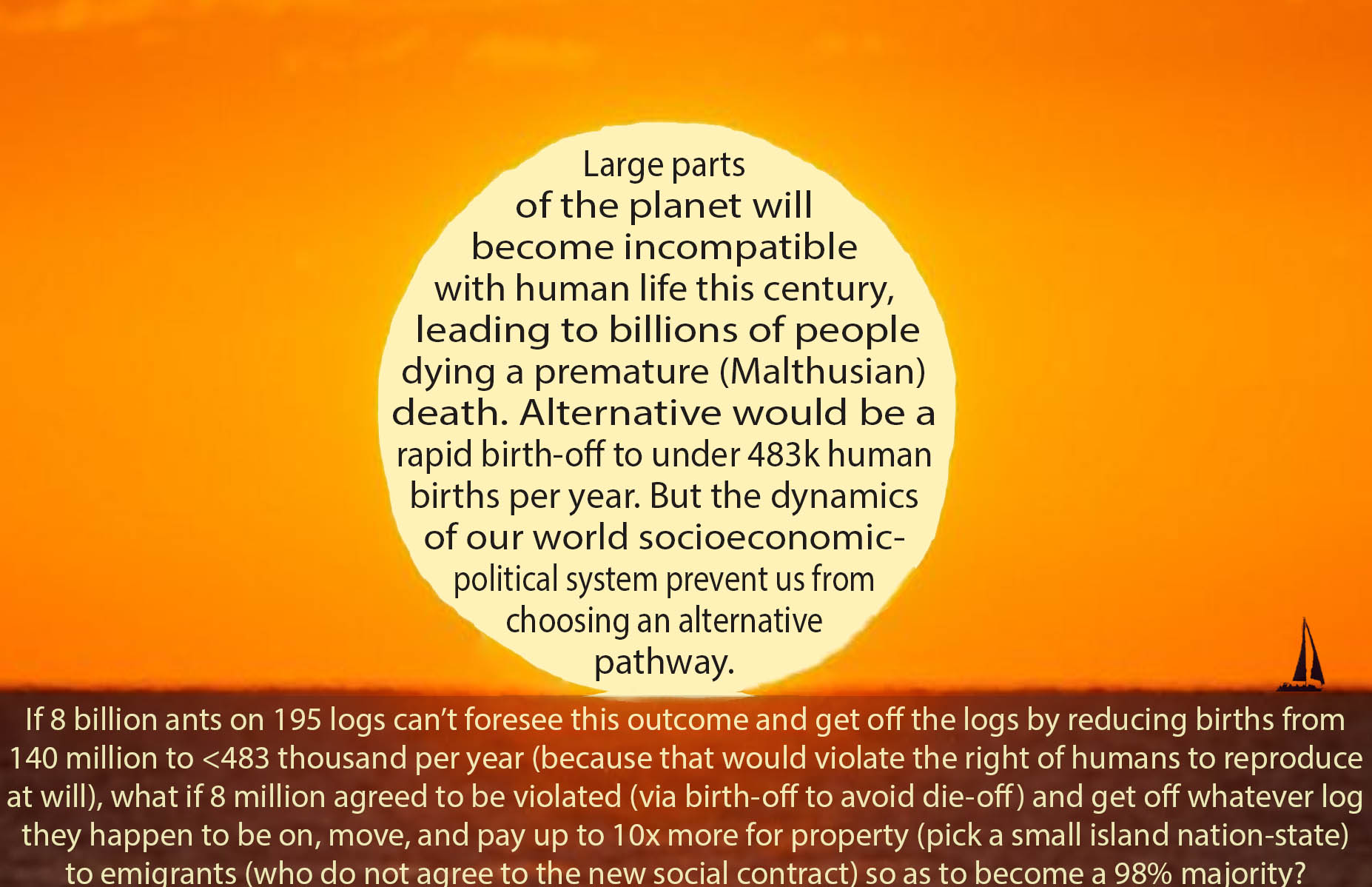
A rapid birth-off involves having only as many births as are needed to maintain a long-term viable population well within carrying capacity regardless of the initial size of the population. Without fossil fuel inputs, initial to final population size may be in a 10:1 to 250:1 range depending on initial:carrying capacity. Humans do not determine carrying capacity. They can decrease carrying capacity by degrading the life-support system, or via systemic management, marginally increase carrying capacity as the centuries pass. A marginal decrease in population can allow a marginal increase in abundance of renewable resources (e.g. soil, food, biomass) per capita.
If 8 million (0.1%) is vastly more than could agree to live within limits, what if 8 thousand (the 0.0001%) could? If one billionaire provided a bit of money….
Oh, one did, bought Lānai ($300 million), a 23 sq mi island in 2012, so… or if the 8k had on average a half million dollars,… and 8k people moved there, then that could be a start.
Per new social contract, they would self-organize into 180 communities (villages, hamlets…) of about 45 members each. Needs in the form of stored dry goods (e.g. food, seeds, clothing, books, aspirin, morphine…) provided to last initial population a lifetime. Temporary shelter provided, along with information on how to construct housing using local materials and grow/consume foods. There will be no fossil fuel inputs, direct or indirect, apart from the initial dry goods. The principle is H.T. Odum’s “seek out the condition now that will come anyway.”
Per best guess of population biologists/ecologists, sustainable population is 2,000. Assuming an average lifespan of 75 years (no one dies a Malthusian death), 28 babies need to be born each year starting from year 1 (but no more, period, full stop). Initially one baby per community in first 6.4 years. In 100 years, one baby born on average every 1.6 years per community, total population 2,000.
In 50 years, 28 babies will be born each year and the average women will have 2.1 children (initially all potential mothers agree that one in four of them will become mothers per best-guess decisions made by existing mothers of the community they live in, and if initial population is 20k, the only difference is one in ten of potential mothers become mothers). The initial 180 communities (445 communities if initial population is 20k) will have contracted/consolidated by mostly old age death to about 45 largely self-sufficient communities (ask Ted Trainer how).
Death rates and carrying capacity may change, so births per year could change slightly, but such are the cold equations that Nature determines — not humans. In 100 years there will be 2,000 prosperous people living well within the environmental productivity of the island. If they want a more prosperous life, fewer babies will be born each year (degrowth will be too slow to notice).
All of our K-culture hominin ancestors for over six million years understood Nature’s way, and as functional K-strategists (via GAS, General Adaptation Syndrome) their population remained below the upper carrying capacity (under penalty of overshoot injury including local extinction of population).
The people living on North Sentinel Island (60 km2, 23 sq mi) still live within limits as no one ever leaves the island and anyone who comes (and stays too long) is put to death. They must be living within the island’s carrying capacity as the centuries pass. This is what “their” island looks like.
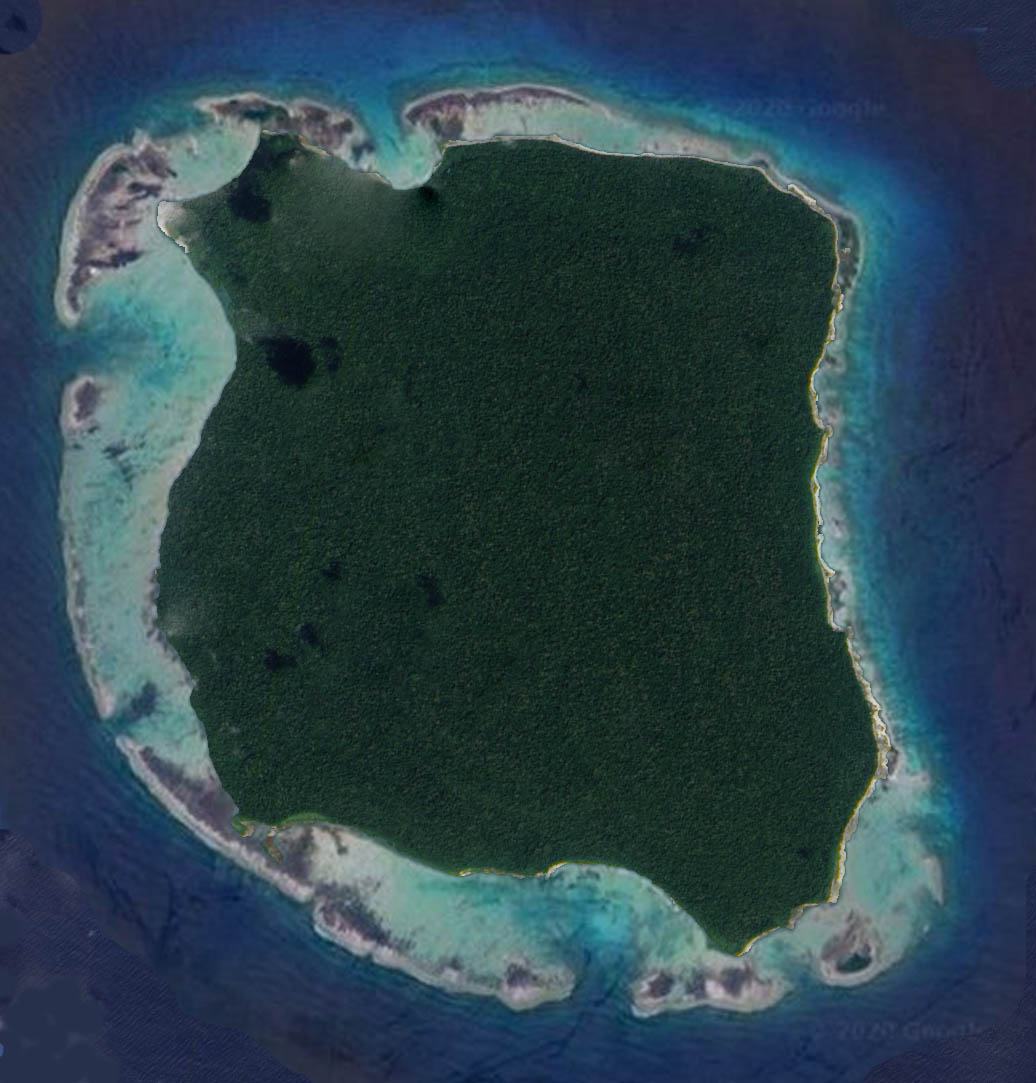 10 camps, maybe 25 people each, or 250 total population (range 50–400).
10 camps, maybe 25 people each, or 250 total population (range 50–400).
They intentionally isolate themselves from us (for some crazy reason):
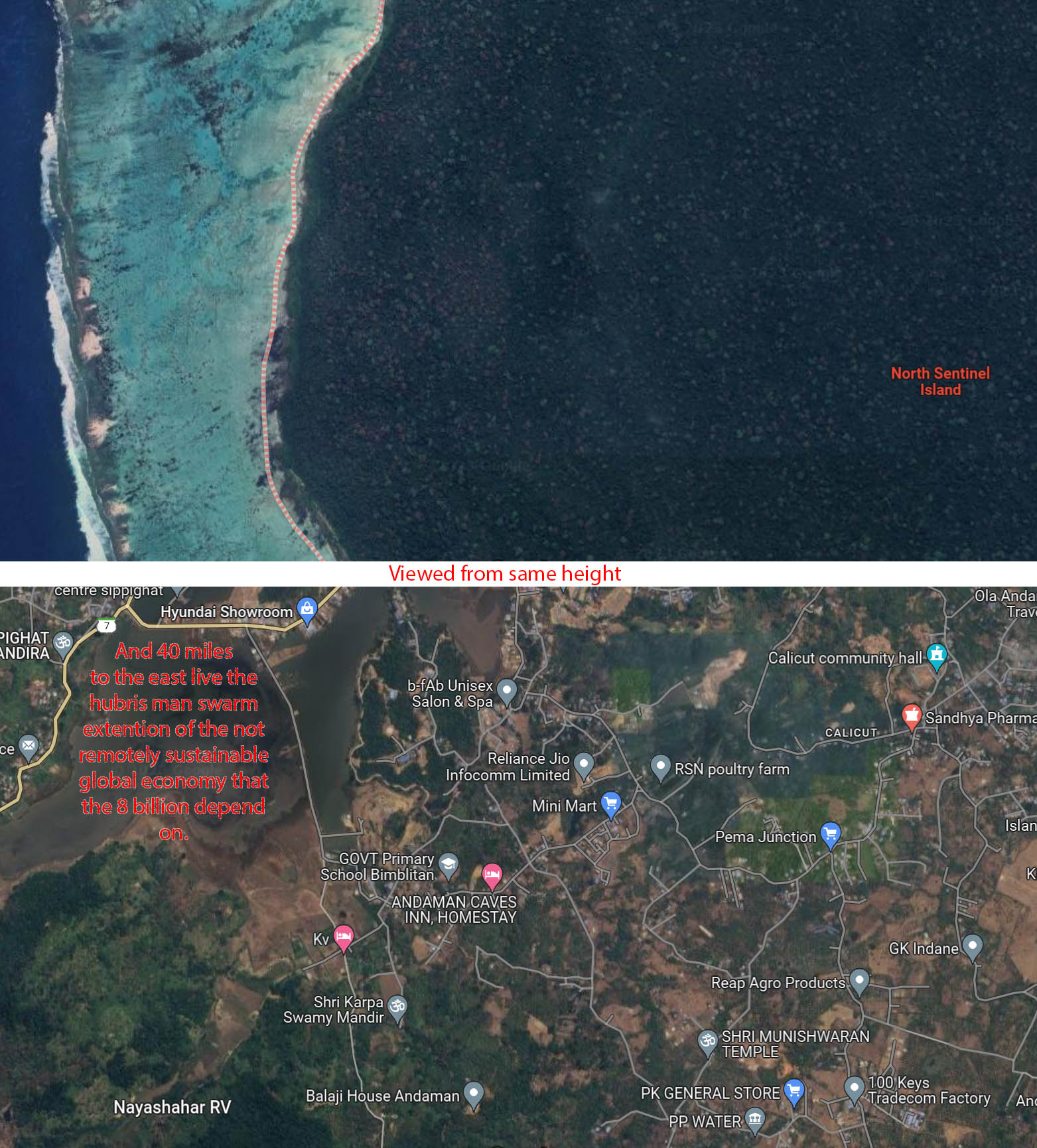 But what can you do? Well, you could walk away, vote with your feet… if you could cease to be a political animal
But what can you do? Well, you could walk away, vote with your feet… if you could cease to be a political animaland seek to renormalize. I’m not asking you to. You can’t choose to. Believe nothing I say. You can understand,
listen to Nature (as evidenced by doing) or die.
To understand something is to be delivered from it.

